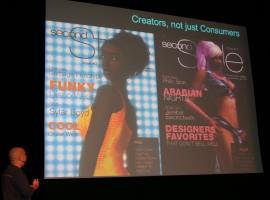BOSTON--Is a fashion and tech industry partnership the equivalent of mixing plaids with stripes, or is this a case of black and white being the perfect match?
After all, there are not many tech events where you need an Italian translator on hand.

John Lester, director of business development and academic programs at Linden Labs, shows Second Life's ''Second Style' fashion magazine.
(Credit: Candace Lombardi/CNET Networks)Members from both groups eagerly met Tuesday to discuss their mating potential at a place they could both feel comfortable--the Institute of Contemporary Art (ICA) in Boston. The event was hosted by Moda e Technologia, an Italian nonprofit organization that promotes fashion and tech exchange. Big names present included Linden Labs, the Massachusetts Institute of Technology, Dolce & Gabbana, Max Mara, and Italian filmmaker Giacomo Faenza who showed his online short Gadget Men.
A fashion-technology partnership is an obvious benefit for both industries. Venues like Second Life or My Virtual Model could serve as a place for the fashion industry to promote brands and virtually develop the worlds they attempt to create through their clothing lines. Fashion jumping into the world of Web 2.0, virtual worlds, and tech-related products could in turn draw in mainstream shoppers who might not have otherwise bothered before with that kind of tech.

But the event itself revealed fundamental differences, with one crowd easily slipping into presentations with their laptops and the others needing a little tech support when their turn came.
Dolce & Gabbana is known for having already jumped headfirst into technology with digital media promotions, cell phones, ring tones, and wallpaper. They are one of the fashion companies that do seem to get that they can use the Internet and its new tools to both enhance brand image and create new streams of revenue. But even their own digital marketing guy said it could be hard to convince companies to understand the importance of creating things like a virtual presence and products for avatars. Dennis Valle, director of media interaction at Dolce & Gabbana, said that the move to digital is a big jump that will require teaching a whole industry a new vocabulary and explanation of context.
People in the fashion industry normally do their advertising through their fabric and their market research by talking to people out in the world when they travel, he said.
"Advergame, edutainment, advertorial, and docudrama are new terms that will become part of companies' everyday use...Sensorial marketing, a way to understand consumers' actions, thoughts, and intentions, could translate into a new way to meet their needs," Valle said.
After giving a forthright and informative presentation on My Virtual Model, an avatar creation site that incorporates brand name clothes, Louise Guay, the company's president and founder, was met with a question that showed not everyone in her audience had started with her from the same place.

Marina Garzoni, founder of Moda e Technologia, a Milan-based non-profit organization that seeks to bring tech and fashion together.
(Credit: Candace Lombardi/CNET Networks)So how much do people pay to use this avatar person, asked one audience member? She raised her eyebrows in delightful surprise once Guay explained that it was not the user who paid, but the company promoting the brand.
John Lester, director of business development and academic programs at Linden Labs, explained Second Life's business model by comparing its in-world users to people browsing the Internet for free and its islands or presences as hosted Web sites.
Lester, on the other hand, was not as savvy when it came to fashion. He proudly explained the user-friendly way in which people can incorporate clothing and body parts into their Second Life avatars with a runway worthy slide show and real-time presentation of fashion forward avatars in Second Life. But when he pointed out that friends can even duplicate outfits so they can wear the same thing, he was met with a few snickers and giggles from the audience.
He did, however, manage to hit the important points.
"Whatever you do in Second Life you retain all of the intellectual property rights...Our community is more gender-balanced...our user base has a median age of 35, and it's very international with 70 percent of users outside the U.S.," he said.
What's more, Second Life already has a thriving fashion scene including lighting effects, night clubs, dancing, and even its own Vogue equivalent. He showed Second Style, a virtual magazine whose publisher makes money by selling ad space to retailers of not just avatar clothes, but body parts like noses, lips, and hair. During one phenomenon, Second Life avatars even carried around chickens as an accessory.
Now that's something you don't see on the runway.
Related News
Photos
More>>trade
market
- UAE : Liali to create a romantic bond with your Valentine
- Netherlands : Stahl presents leather & technology forecast for S/S 2009
- UK : Textiles at Work 2008 by Performance Textiles Association
- USA : 2008 AHEAD Men's Authentics line "PERFORMANCE"
- UAE : Milia M to showcase fashion collection at Milano





